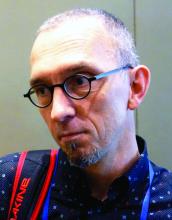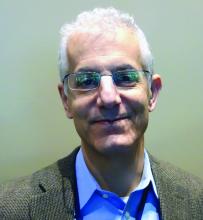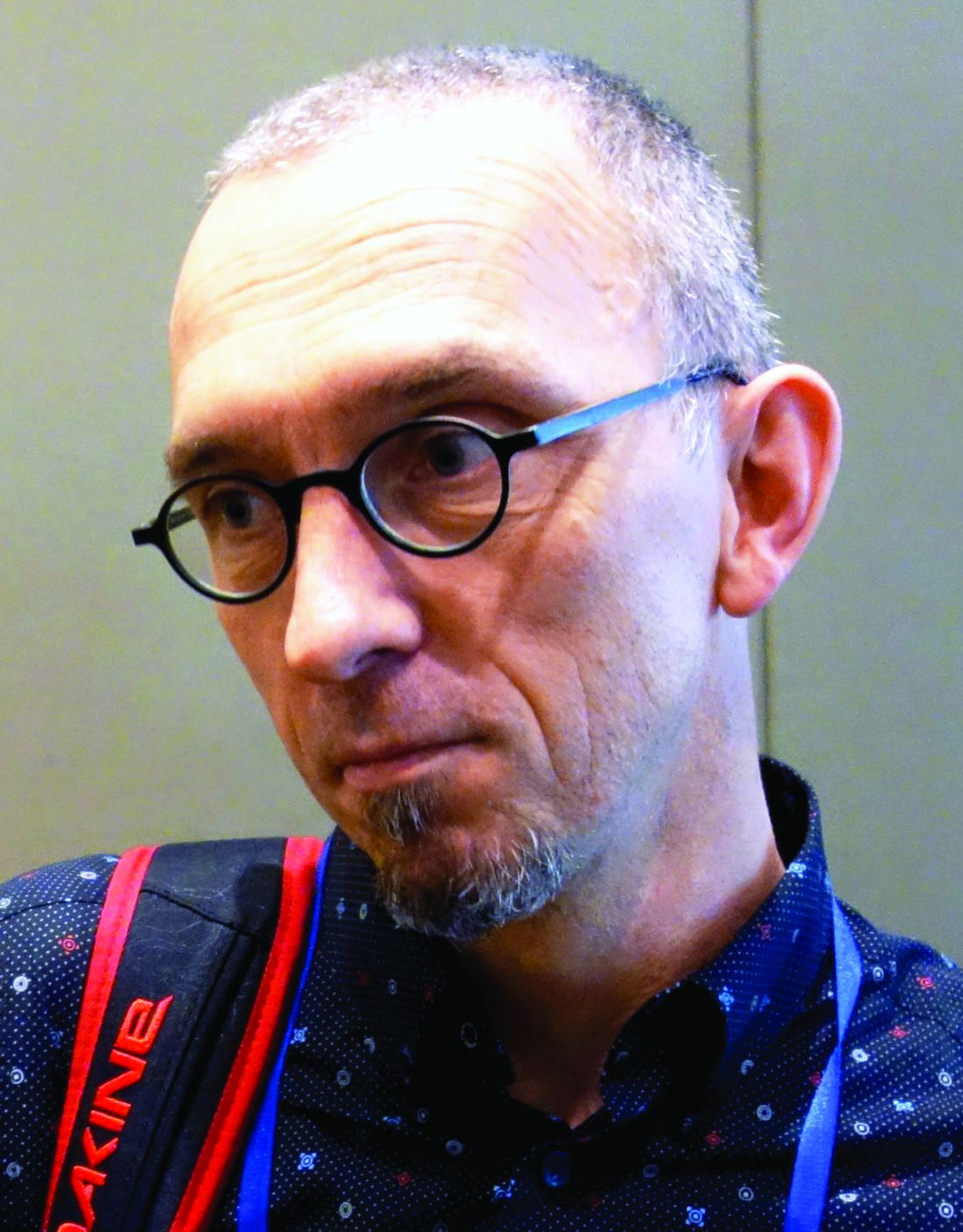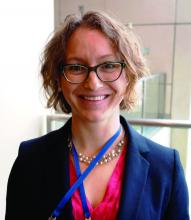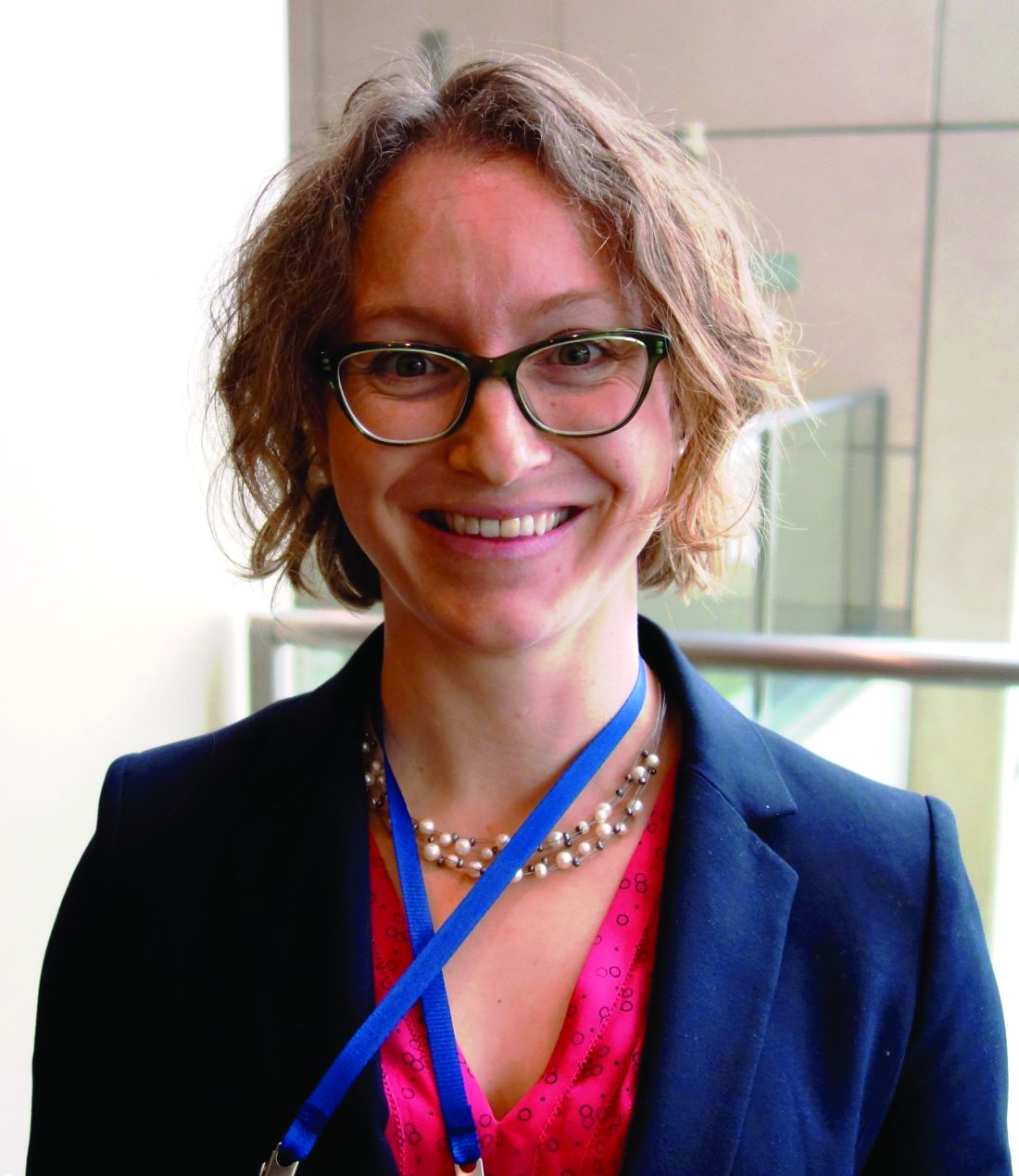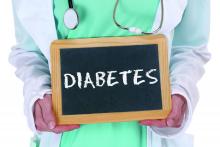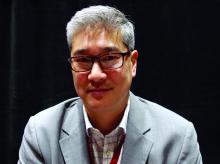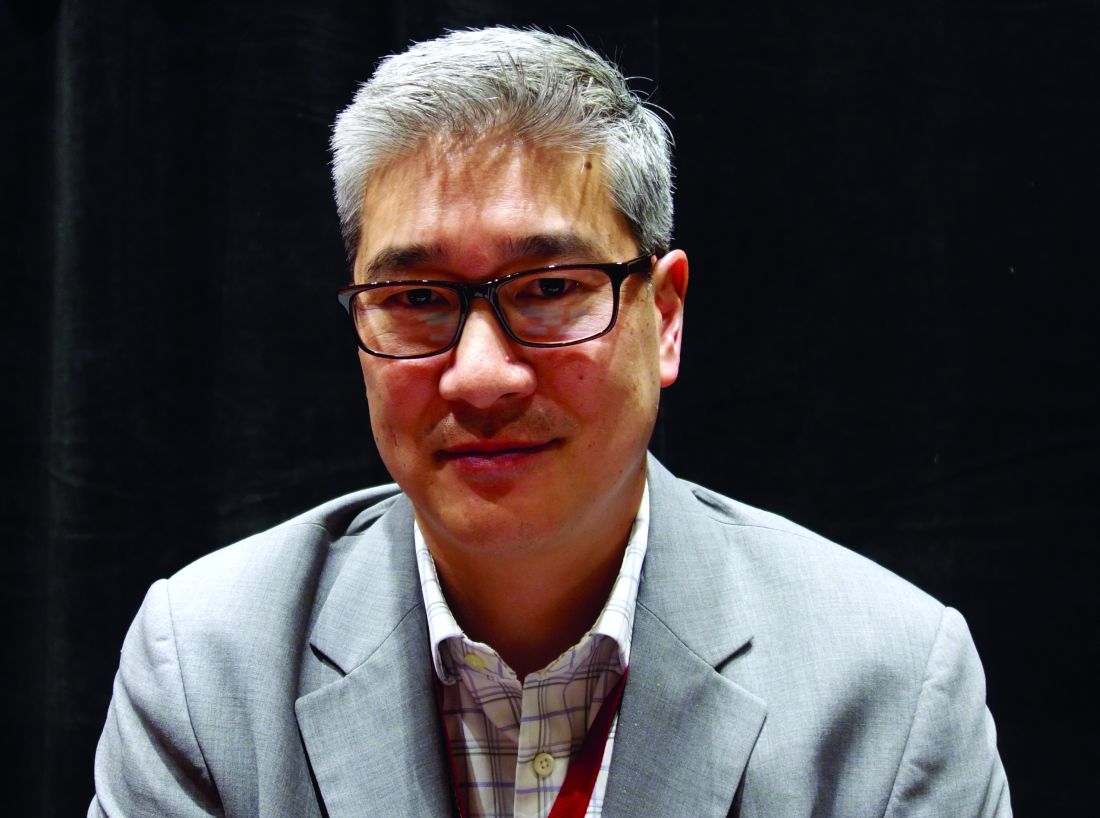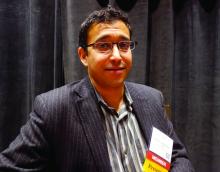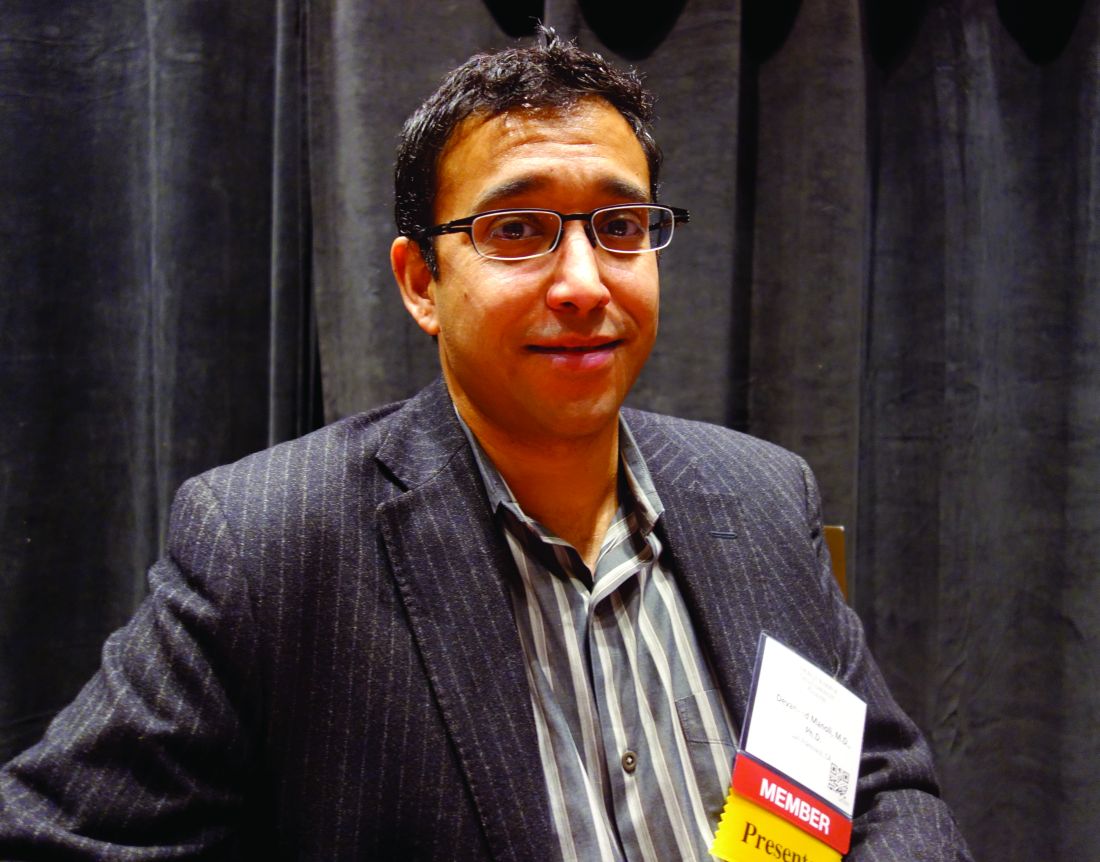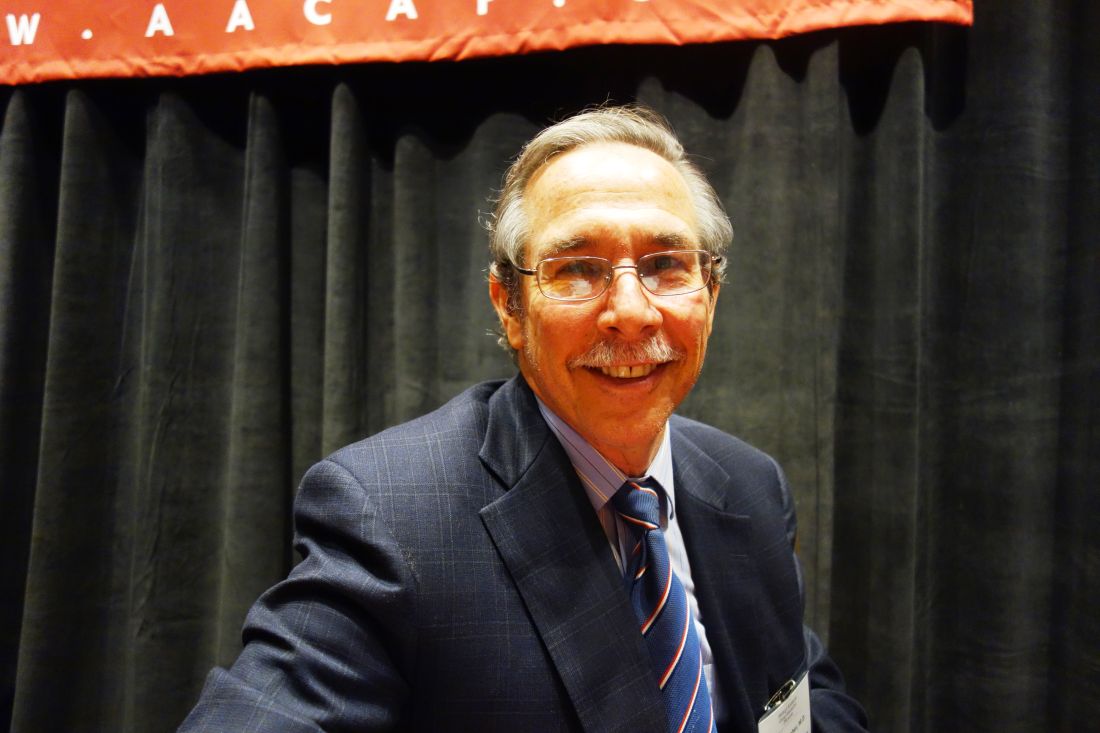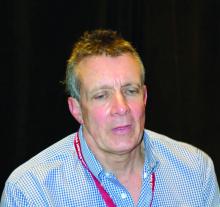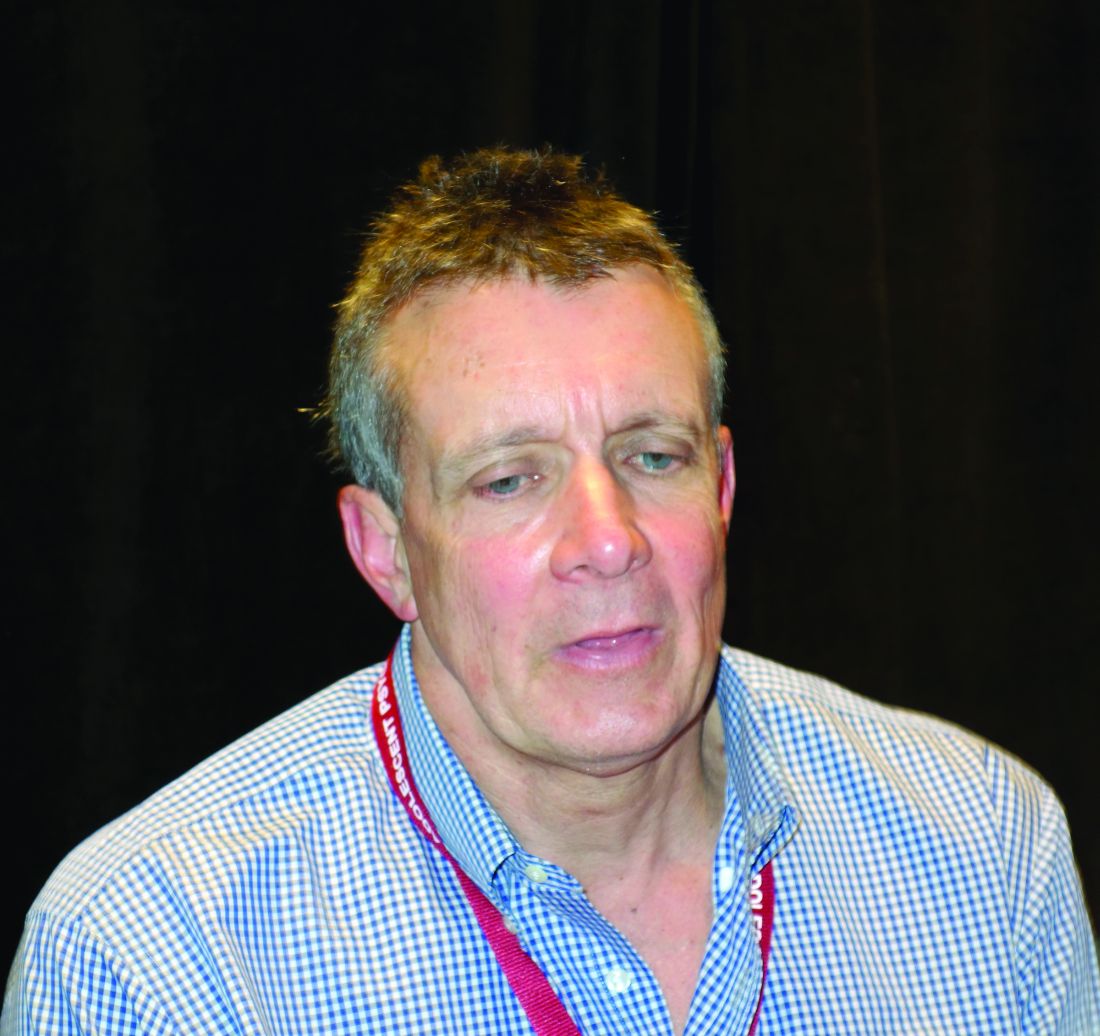User login
M. Alexander Otto began his reporting career early in 1999 covering the pharmaceutical industry for a national pharmacists' magazine and freelancing for the Washington Post and other newspapers. He then joined BNA, now part of Bloomberg News, covering health law and the protection of people and animals in medical research. Alex next worked for the McClatchy Company. Based on his work, Alex won a year-long Knight Science Journalism Fellowship to MIT in 2008-2009. He joined the company shortly thereafter. Alex has a newspaper journalism degree from Syracuse (N.Y.) University and a master's degree in medical science -- a physician assistant degree -- from George Washington University. Alex is based in Seattle.
Following infection, semen is Zika’s last refuge
SEATTLE – Zika virus RNA lingered longer in semen than in any other body fluid but was cleared by 95% of men after 3 months, according to investigators from the Centers for Disease Control and Prevention.
The findings support the agency’s recommendation that men abstain from sex or use a condom for 6 months after coming down with symptoms. There had been concern following case reports of two men with semen positive for Zika RNA beyond 180 days, but further study supported the recommendation.
Many wondered if 6 months was too short, creating “a lot of anxiety and some confusion. It was good to find that [6 months is fine],” said senior CDC epidemiologist and lead investigator Gabriela Paz-Bailey, MD. “Based on our findings, late detection seems rare,” and the longest any infectious virus has been found in semen is 69 days.
The investigation team collected body fluids for 6 months from 150 patients in Puerto Rico who had confirmed Zika infection. Samples included semen samples from 55 men and vaginal secretions from 95 women in the study. Most of the participants presented to a hospital with symptoms, but some were household contacts who didn’t remember symptoms until asked.
“We found that two out of every three people who have evidence of infection reported symptoms,” which was higher than what was expected for an infection thought to be asymptomatic in many who remembered symptoms only when drilled by persistent epidemiologists. “You have to ask the questions,” Dr. Paz-Bailey said at the annual Conference on Retroviruses & Opportunistic Infections in partnership with the International Antiviral Society.
The samples were tested by reverse transcriptase polymerase chain reaction to see how long viral RNA stayed in various body fluids. Urine often is used to screen patients for Zika RNA, but the team found that virus evidence lasts longer in serum. While half of patients still had Zika RNA in their serum 2 weeks after symptom onset, and 5% were positive after about 2 months, urine was positive for Zika RNA in half of patients for only about a week. After 39 days, only 5% had RNA in their urine.
“It was thought that you could detect the virus more often in urine. We found the opposite. This is new. Serum may be a superior diagnostic specimen compared to urine,” Dr. Paz-Bailey said.
Additionally, RNA was found in semen longer than any other fluid, with about half of men positive after a month and 5% at about 3 months. The maximum for detection of Zika RNA in semen was 125 days. Meanwhile, RNA was largely undetectable in saliva and vaginal fluids after a week.
Until now, the 6-month window for men has been based on case reports and cross-sectional observations, mostly of travelers returning to the United States. The new findings bolster the 6-month abstinence or condom use recommendation but also support advice that women avoid pregnancy for 2 months following symptom onset, although the evidence for a 2-month window in women isn’t as strong.
The serum findings “suggest that the risk of intrauterine transmission ... is small” in women trying to conceive toward the end of the 2-month period, but “we will continue to monitor women of reproductive age to inform evaluations of these recommendations,” Dr. Paz-Bailey and her colleagues said in a report published after the presentation (N Engl J Med. 2017 Feb 14. doi: 10.1056/NEJMoa1613108).
It’s unclear if finding Zika RNA in body fluids means that there’s still active virus that can be transmitted. The team is plating out their specimens to see if they grow live virus.
The results are from an interim analysis. CDC plans to recruit at least 300 people into the study.
Dr. Paz-Bailey had no relevant financial disclosures. CDC funded the work.
SEATTLE – Zika virus RNA lingered longer in semen than in any other body fluid but was cleared by 95% of men after 3 months, according to investigators from the Centers for Disease Control and Prevention.
The findings support the agency’s recommendation that men abstain from sex or use a condom for 6 months after coming down with symptoms. There had been concern following case reports of two men with semen positive for Zika RNA beyond 180 days, but further study supported the recommendation.
Many wondered if 6 months was too short, creating “a lot of anxiety and some confusion. It was good to find that [6 months is fine],” said senior CDC epidemiologist and lead investigator Gabriela Paz-Bailey, MD. “Based on our findings, late detection seems rare,” and the longest any infectious virus has been found in semen is 69 days.
The investigation team collected body fluids for 6 months from 150 patients in Puerto Rico who had confirmed Zika infection. Samples included semen samples from 55 men and vaginal secretions from 95 women in the study. Most of the participants presented to a hospital with symptoms, but some were household contacts who didn’t remember symptoms until asked.
“We found that two out of every three people who have evidence of infection reported symptoms,” which was higher than what was expected for an infection thought to be asymptomatic in many who remembered symptoms only when drilled by persistent epidemiologists. “You have to ask the questions,” Dr. Paz-Bailey said at the annual Conference on Retroviruses & Opportunistic Infections in partnership with the International Antiviral Society.
The samples were tested by reverse transcriptase polymerase chain reaction to see how long viral RNA stayed in various body fluids. Urine often is used to screen patients for Zika RNA, but the team found that virus evidence lasts longer in serum. While half of patients still had Zika RNA in their serum 2 weeks after symptom onset, and 5% were positive after about 2 months, urine was positive for Zika RNA in half of patients for only about a week. After 39 days, only 5% had RNA in their urine.
“It was thought that you could detect the virus more often in urine. We found the opposite. This is new. Serum may be a superior diagnostic specimen compared to urine,” Dr. Paz-Bailey said.
Additionally, RNA was found in semen longer than any other fluid, with about half of men positive after a month and 5% at about 3 months. The maximum for detection of Zika RNA in semen was 125 days. Meanwhile, RNA was largely undetectable in saliva and vaginal fluids after a week.
Until now, the 6-month window for men has been based on case reports and cross-sectional observations, mostly of travelers returning to the United States. The new findings bolster the 6-month abstinence or condom use recommendation but also support advice that women avoid pregnancy for 2 months following symptom onset, although the evidence for a 2-month window in women isn’t as strong.
The serum findings “suggest that the risk of intrauterine transmission ... is small” in women trying to conceive toward the end of the 2-month period, but “we will continue to monitor women of reproductive age to inform evaluations of these recommendations,” Dr. Paz-Bailey and her colleagues said in a report published after the presentation (N Engl J Med. 2017 Feb 14. doi: 10.1056/NEJMoa1613108).
It’s unclear if finding Zika RNA in body fluids means that there’s still active virus that can be transmitted. The team is plating out their specimens to see if they grow live virus.
The results are from an interim analysis. CDC plans to recruit at least 300 people into the study.
Dr. Paz-Bailey had no relevant financial disclosures. CDC funded the work.
SEATTLE – Zika virus RNA lingered longer in semen than in any other body fluid but was cleared by 95% of men after 3 months, according to investigators from the Centers for Disease Control and Prevention.
The findings support the agency’s recommendation that men abstain from sex or use a condom for 6 months after coming down with symptoms. There had been concern following case reports of two men with semen positive for Zika RNA beyond 180 days, but further study supported the recommendation.
Many wondered if 6 months was too short, creating “a lot of anxiety and some confusion. It was good to find that [6 months is fine],” said senior CDC epidemiologist and lead investigator Gabriela Paz-Bailey, MD. “Based on our findings, late detection seems rare,” and the longest any infectious virus has been found in semen is 69 days.
The investigation team collected body fluids for 6 months from 150 patients in Puerto Rico who had confirmed Zika infection. Samples included semen samples from 55 men and vaginal secretions from 95 women in the study. Most of the participants presented to a hospital with symptoms, but some were household contacts who didn’t remember symptoms until asked.
“We found that two out of every three people who have evidence of infection reported symptoms,” which was higher than what was expected for an infection thought to be asymptomatic in many who remembered symptoms only when drilled by persistent epidemiologists. “You have to ask the questions,” Dr. Paz-Bailey said at the annual Conference on Retroviruses & Opportunistic Infections in partnership with the International Antiviral Society.
The samples were tested by reverse transcriptase polymerase chain reaction to see how long viral RNA stayed in various body fluids. Urine often is used to screen patients for Zika RNA, but the team found that virus evidence lasts longer in serum. While half of patients still had Zika RNA in their serum 2 weeks after symptom onset, and 5% were positive after about 2 months, urine was positive for Zika RNA in half of patients for only about a week. After 39 days, only 5% had RNA in their urine.
“It was thought that you could detect the virus more often in urine. We found the opposite. This is new. Serum may be a superior diagnostic specimen compared to urine,” Dr. Paz-Bailey said.
Additionally, RNA was found in semen longer than any other fluid, with about half of men positive after a month and 5% at about 3 months. The maximum for detection of Zika RNA in semen was 125 days. Meanwhile, RNA was largely undetectable in saliva and vaginal fluids after a week.
Until now, the 6-month window for men has been based on case reports and cross-sectional observations, mostly of travelers returning to the United States. The new findings bolster the 6-month abstinence or condom use recommendation but also support advice that women avoid pregnancy for 2 months following symptom onset, although the evidence for a 2-month window in women isn’t as strong.
The serum findings “suggest that the risk of intrauterine transmission ... is small” in women trying to conceive toward the end of the 2-month period, but “we will continue to monitor women of reproductive age to inform evaluations of these recommendations,” Dr. Paz-Bailey and her colleagues said in a report published after the presentation (N Engl J Med. 2017 Feb 14. doi: 10.1056/NEJMoa1613108).
It’s unclear if finding Zika RNA in body fluids means that there’s still active virus that can be transmitted. The team is plating out their specimens to see if they grow live virus.
The results are from an interim analysis. CDC plans to recruit at least 300 people into the study.
Dr. Paz-Bailey had no relevant financial disclosures. CDC funded the work.
AT CROI
Key clinical point:
Major finding: Semen still had detectable Zika RNA in about half of men after a month and 5% at about 3 months. The maximum for detection in semen was 125 days.
Data source: A study of 150 patients in Puerto Rica with confirmed Zika infection.
Disclosures: The lead investigator had no disclosures. CDC funded the work.
Unrestricted DAA access halved Dutch HCV incidence in HIV
SEATTLE – New hepatitis C infections among HIV-positive men who have sex with men (MSM) were halved in the Netherlands by unrestricted access to direct-acting antivirals (DAAs), primarily ledipasvir/sofosbuvir tablets (Harvoni), according to Dutch investigators.
Since 2015, DAAs have been available to all newly acquired hepatitis C virus (HCV) patients without restriction. Due to the high cost of the drugs, payers in the United States and some other Western countries limit access to only patients with severe liver disease.*
The Dutch government, however, requires insurers to cover them, and has negotiated price discounts with makers. “The price that is paid is secret,” but it’s less than the standard cost of, for instance, €45,000 for a 3-month course of [ledipasvir/sofosbuvir] in the Netherlands, said senior investigator Bart Rijnders, MD, an infectious diseases assistant professor at Erasmus University Medical Center, Rotterdam.
The study compared the incidence of acute HCV (aHCV) in HIV-positive MSM in 2014, before unrestricted access to DAAs, to the incidence of aHCV in 2016, after limits were lifted. The investigators used data from 18 HIV treatment centers spread across the Netherlands, capturing about 80% of Dutch MSM being treated for HIV.
In 2014, there were 93 aHCV infections diagnosed among the men, translating to an incidence of 11.2 cases per 1,000 person-years of follow-up (95% CI, 9.1-13.7 cases). In 2016, there were 49 aHCV cases, an incidence of 5.5 cases per 1,000 person-years (95% CI, 4.1–7.2, P less than .001). At the same time, there was a substantial increase in new syphilis cases, indicating that the 51% reduction in aHCV over 2 years was not due to changes in behavior.
Meanwhile, “within 14 months after these drugs became available to all, 75% of the HIV-positive MSM in the Netherlands were cured of their infection,” Dr. Rijnders said at the Conference on Retroviruses & Opportunistic Infections in partnership with the International Antiviral Society.
Ledipasvir/sofosbuvir was the DAA used by about 90% of the men.
In short, unrestricted access to DAAs wiped out the infection so that men were no longer passing it to other men. The results are “an example of what is possible if you search for HCV and treat it as soon as you find it. You cure patients and prevent new infections. In the long run, you may save money,” he said, especially as more DAA options come on the market and prices fall.
Almost all the subjects were seen in their HIV clinic at least twice a year. An uptick in liver enzymes triggered HCV testing. The investigators checked positive results against patients’ own stored blood samples to distinguish new from chronic infections.
The study wasn’t funded, but Dr. Rijnders is a paid researcher for Merck’s DAA option, elbasvir/grazoprevir (Zepatier).
*This story was updated on February 24, 2017.
This is the first proof that early treatment of acute HCV could be a form of prevention. By removing the fibrosis requirement and restrictions forbidding treatment of people who are actively engaged in high-risk behaviors, they are reducing new infections.
We are far behind in the United States; 90% of states have restrictions that don’t allow uniform uptake of hepatitis C treatment and many forbid treatment for people who are actively using drugs. Having restrictions on people that don’t have enough liver disease is like telling a person with HIV they can’t be treated because their CD4 count isn’t below 200.
David Thomas, MD, is professor of medicine and director of the division of infectious diseases at Johns Hopkins University, Baltimore. He wasn’t involved with the work.
This is the first proof that early treatment of acute HCV could be a form of prevention. By removing the fibrosis requirement and restrictions forbidding treatment of people who are actively engaged in high-risk behaviors, they are reducing new infections.
We are far behind in the United States; 90% of states have restrictions that don’t allow uniform uptake of hepatitis C treatment and many forbid treatment for people who are actively using drugs. Having restrictions on people that don’t have enough liver disease is like telling a person with HIV they can’t be treated because their CD4 count isn’t below 200.
David Thomas, MD, is professor of medicine and director of the division of infectious diseases at Johns Hopkins University, Baltimore. He wasn’t involved with the work.
This is the first proof that early treatment of acute HCV could be a form of prevention. By removing the fibrosis requirement and restrictions forbidding treatment of people who are actively engaged in high-risk behaviors, they are reducing new infections.
We are far behind in the United States; 90% of states have restrictions that don’t allow uniform uptake of hepatitis C treatment and many forbid treatment for people who are actively using drugs. Having restrictions on people that don’t have enough liver disease is like telling a person with HIV they can’t be treated because their CD4 count isn’t below 200.
David Thomas, MD, is professor of medicine and director of the division of infectious diseases at Johns Hopkins University, Baltimore. He wasn’t involved with the work.
SEATTLE – New hepatitis C infections among HIV-positive men who have sex with men (MSM) were halved in the Netherlands by unrestricted access to direct-acting antivirals (DAAs), primarily ledipasvir/sofosbuvir tablets (Harvoni), according to Dutch investigators.
Since 2015, DAAs have been available to all newly acquired hepatitis C virus (HCV) patients without restriction. Due to the high cost of the drugs, payers in the United States and some other Western countries limit access to only patients with severe liver disease.*
The Dutch government, however, requires insurers to cover them, and has negotiated price discounts with makers. “The price that is paid is secret,” but it’s less than the standard cost of, for instance, €45,000 for a 3-month course of [ledipasvir/sofosbuvir] in the Netherlands, said senior investigator Bart Rijnders, MD, an infectious diseases assistant professor at Erasmus University Medical Center, Rotterdam.
The study compared the incidence of acute HCV (aHCV) in HIV-positive MSM in 2014, before unrestricted access to DAAs, to the incidence of aHCV in 2016, after limits were lifted. The investigators used data from 18 HIV treatment centers spread across the Netherlands, capturing about 80% of Dutch MSM being treated for HIV.
In 2014, there were 93 aHCV infections diagnosed among the men, translating to an incidence of 11.2 cases per 1,000 person-years of follow-up (95% CI, 9.1-13.7 cases). In 2016, there were 49 aHCV cases, an incidence of 5.5 cases per 1,000 person-years (95% CI, 4.1–7.2, P less than .001). At the same time, there was a substantial increase in new syphilis cases, indicating that the 51% reduction in aHCV over 2 years was not due to changes in behavior.
Meanwhile, “within 14 months after these drugs became available to all, 75% of the HIV-positive MSM in the Netherlands were cured of their infection,” Dr. Rijnders said at the Conference on Retroviruses & Opportunistic Infections in partnership with the International Antiviral Society.
Ledipasvir/sofosbuvir was the DAA used by about 90% of the men.
In short, unrestricted access to DAAs wiped out the infection so that men were no longer passing it to other men. The results are “an example of what is possible if you search for HCV and treat it as soon as you find it. You cure patients and prevent new infections. In the long run, you may save money,” he said, especially as more DAA options come on the market and prices fall.
Almost all the subjects were seen in their HIV clinic at least twice a year. An uptick in liver enzymes triggered HCV testing. The investigators checked positive results against patients’ own stored blood samples to distinguish new from chronic infections.
The study wasn’t funded, but Dr. Rijnders is a paid researcher for Merck’s DAA option, elbasvir/grazoprevir (Zepatier).
*This story was updated on February 24, 2017.
SEATTLE – New hepatitis C infections among HIV-positive men who have sex with men (MSM) were halved in the Netherlands by unrestricted access to direct-acting antivirals (DAAs), primarily ledipasvir/sofosbuvir tablets (Harvoni), according to Dutch investigators.
Since 2015, DAAs have been available to all newly acquired hepatitis C virus (HCV) patients without restriction. Due to the high cost of the drugs, payers in the United States and some other Western countries limit access to only patients with severe liver disease.*
The Dutch government, however, requires insurers to cover them, and has negotiated price discounts with makers. “The price that is paid is secret,” but it’s less than the standard cost of, for instance, €45,000 for a 3-month course of [ledipasvir/sofosbuvir] in the Netherlands, said senior investigator Bart Rijnders, MD, an infectious diseases assistant professor at Erasmus University Medical Center, Rotterdam.
The study compared the incidence of acute HCV (aHCV) in HIV-positive MSM in 2014, before unrestricted access to DAAs, to the incidence of aHCV in 2016, after limits were lifted. The investigators used data from 18 HIV treatment centers spread across the Netherlands, capturing about 80% of Dutch MSM being treated for HIV.
In 2014, there were 93 aHCV infections diagnosed among the men, translating to an incidence of 11.2 cases per 1,000 person-years of follow-up (95% CI, 9.1-13.7 cases). In 2016, there were 49 aHCV cases, an incidence of 5.5 cases per 1,000 person-years (95% CI, 4.1–7.2, P less than .001). At the same time, there was a substantial increase in new syphilis cases, indicating that the 51% reduction in aHCV over 2 years was not due to changes in behavior.
Meanwhile, “within 14 months after these drugs became available to all, 75% of the HIV-positive MSM in the Netherlands were cured of their infection,” Dr. Rijnders said at the Conference on Retroviruses & Opportunistic Infections in partnership with the International Antiviral Society.
Ledipasvir/sofosbuvir was the DAA used by about 90% of the men.
In short, unrestricted access to DAAs wiped out the infection so that men were no longer passing it to other men. The results are “an example of what is possible if you search for HCV and treat it as soon as you find it. You cure patients and prevent new infections. In the long run, you may save money,” he said, especially as more DAA options come on the market and prices fall.
Almost all the subjects were seen in their HIV clinic at least twice a year. An uptick in liver enzymes triggered HCV testing. The investigators checked positive results against patients’ own stored blood samples to distinguish new from chronic infections.
The study wasn’t funded, but Dr. Rijnders is a paid researcher for Merck’s DAA option, elbasvir/grazoprevir (Zepatier).
*This story was updated on February 24, 2017.
AT CROI
Key clinical point:
Major finding: In 2014, there were 93 acute HCV infections diagnosed among HIV-positive men who have sex with men, translating to an incidence of 11.2 cases per 1,000 person-years of follow-up (95% CI, 9.1-13.7 cases). In 2016, there were 49 cases, an incidence of 5.5 cases per 1,000 person years (95% CI, 4.1–7.2, P less than .001).
Data source: HIV treatment centers in the Netherlands
Disclosures: The study wasn’t funded, but the senior investigator is a paid researcher for Merck’s DAA option, elbasvir/grazoprevir (Zepatier).
LEEP tops cryotherapy for cervical dysplasia in women with HIV
SEATTLE – HIV-positive women treated with cryotherapy for cervical intraepithelial neoplasia (CIN) 2/3 were 52% more likely than women treated with loop excision to have a recurrence within 2 years, according to a randomized trial in Kenya.
The investigators called on the World Health Organization and other groups to support loop excision as the first-line option for HIV-positive women in sub-Saharan Africa and other low-resource settings, but the findings also support its use, when possible, in Western countries.
For the study, 200 HIV-positive women were randomized to cryotherapy and 200 to LEEP for treatment of CIN 2/3 at the Coptic Hope Center for Infectious Diseases in Nairobi, with follow-up Pap smears every 6 months afterwards for 2 years.
At 12 months, 36 women in the LEEP group (18%) had recurrent high-grade squamous intraepithelial lesions (HSIL), versus 54 women (27%) in the cryotherapy arm. At 24 months, HSIL was detected in 52 women who had LEEP (26%), versus 74 who had cryotherapy (37%).
Overall, the rate of recurrence of HSIL was 21.1 per 100 woman-years after cryotherapy and 14.0 per 100 woman-years after LEEP.
It’s unclear how those results would have played out in the United States, Ms. Green said, noting that LEEP failure rates are far lower among women who do not have HIV, but the success of LEEP in HIV-positive women in the United States has not been well studied.
The World Health Organization “recommends posttreatment follow-up at 12 months, regardless of HIV status. Our findings indicate that women should be screened at more frequent intervals, particularly following cryotherapy,” she said at the Conference on Retroviruses & Opportunistic Infections in partnership with the International Antiviral Society.
Women were excluded from the study if they were pregnant. The median age was 37 years, and almost all the subjects were on antiretroviral therapy at the time of intervention, with a median CD4 count of 380 cells/mcL. Median follow-up was 2.1 years in both arms; most of the women completed all four follow-up visits. The majority in both groups had CIN 3; about 10 in each arm had carcinoma in situ.
“Cervical screening and treatment using visual inspection with acetic acid and cryotherapy is often implemented in resource-limited settings with high HIV-1 endemicity; however … HIV testing and referral for LEEP may be more effective” and cost effective if it prevents later hysterectomy, Ms. Greene said.
Ms. Greene had no disclosures. The work was funded by the U.S. President’s Emergency Plan for AIDS Relief (PEPFAR) and the Centers for Disease Control and Prevention.
SEATTLE – HIV-positive women treated with cryotherapy for cervical intraepithelial neoplasia (CIN) 2/3 were 52% more likely than women treated with loop excision to have a recurrence within 2 years, according to a randomized trial in Kenya.
The investigators called on the World Health Organization and other groups to support loop excision as the first-line option for HIV-positive women in sub-Saharan Africa and other low-resource settings, but the findings also support its use, when possible, in Western countries.
For the study, 200 HIV-positive women were randomized to cryotherapy and 200 to LEEP for treatment of CIN 2/3 at the Coptic Hope Center for Infectious Diseases in Nairobi, with follow-up Pap smears every 6 months afterwards for 2 years.
At 12 months, 36 women in the LEEP group (18%) had recurrent high-grade squamous intraepithelial lesions (HSIL), versus 54 women (27%) in the cryotherapy arm. At 24 months, HSIL was detected in 52 women who had LEEP (26%), versus 74 who had cryotherapy (37%).
Overall, the rate of recurrence of HSIL was 21.1 per 100 woman-years after cryotherapy and 14.0 per 100 woman-years after LEEP.
It’s unclear how those results would have played out in the United States, Ms. Green said, noting that LEEP failure rates are far lower among women who do not have HIV, but the success of LEEP in HIV-positive women in the United States has not been well studied.
The World Health Organization “recommends posttreatment follow-up at 12 months, regardless of HIV status. Our findings indicate that women should be screened at more frequent intervals, particularly following cryotherapy,” she said at the Conference on Retroviruses & Opportunistic Infections in partnership with the International Antiviral Society.
Women were excluded from the study if they were pregnant. The median age was 37 years, and almost all the subjects were on antiretroviral therapy at the time of intervention, with a median CD4 count of 380 cells/mcL. Median follow-up was 2.1 years in both arms; most of the women completed all four follow-up visits. The majority in both groups had CIN 3; about 10 in each arm had carcinoma in situ.
“Cervical screening and treatment using visual inspection with acetic acid and cryotherapy is often implemented in resource-limited settings with high HIV-1 endemicity; however … HIV testing and referral for LEEP may be more effective” and cost effective if it prevents later hysterectomy, Ms. Greene said.
Ms. Greene had no disclosures. The work was funded by the U.S. President’s Emergency Plan for AIDS Relief (PEPFAR) and the Centers for Disease Control and Prevention.
SEATTLE – HIV-positive women treated with cryotherapy for cervical intraepithelial neoplasia (CIN) 2/3 were 52% more likely than women treated with loop excision to have a recurrence within 2 years, according to a randomized trial in Kenya.
The investigators called on the World Health Organization and other groups to support loop excision as the first-line option for HIV-positive women in sub-Saharan Africa and other low-resource settings, but the findings also support its use, when possible, in Western countries.
For the study, 200 HIV-positive women were randomized to cryotherapy and 200 to LEEP for treatment of CIN 2/3 at the Coptic Hope Center for Infectious Diseases in Nairobi, with follow-up Pap smears every 6 months afterwards for 2 years.
At 12 months, 36 women in the LEEP group (18%) had recurrent high-grade squamous intraepithelial lesions (HSIL), versus 54 women (27%) in the cryotherapy arm. At 24 months, HSIL was detected in 52 women who had LEEP (26%), versus 74 who had cryotherapy (37%).
Overall, the rate of recurrence of HSIL was 21.1 per 100 woman-years after cryotherapy and 14.0 per 100 woman-years after LEEP.
It’s unclear how those results would have played out in the United States, Ms. Green said, noting that LEEP failure rates are far lower among women who do not have HIV, but the success of LEEP in HIV-positive women in the United States has not been well studied.
The World Health Organization “recommends posttreatment follow-up at 12 months, regardless of HIV status. Our findings indicate that women should be screened at more frequent intervals, particularly following cryotherapy,” she said at the Conference on Retroviruses & Opportunistic Infections in partnership with the International Antiviral Society.
Women were excluded from the study if they were pregnant. The median age was 37 years, and almost all the subjects were on antiretroviral therapy at the time of intervention, with a median CD4 count of 380 cells/mcL. Median follow-up was 2.1 years in both arms; most of the women completed all four follow-up visits. The majority in both groups had CIN 3; about 10 in each arm had carcinoma in situ.
“Cervical screening and treatment using visual inspection with acetic acid and cryotherapy is often implemented in resource-limited settings with high HIV-1 endemicity; however … HIV testing and referral for LEEP may be more effective” and cost effective if it prevents later hysterectomy, Ms. Greene said.
Ms. Greene had no disclosures. The work was funded by the U.S. President’s Emergency Plan for AIDS Relief (PEPFAR) and the Centers for Disease Control and Prevention.
AT CROI
Key clinical point:
Major finding: At 12 months, 36 women in the LEEP group (18%) had recurrent high-grade squamous intraepithelial lesions, versus 54 women (27%) in the cryotherapy group. At 24 months, HSIL was detected in 52 women in the LEEP arm (26%) versus 74 who had cryotherapy (37%).
Data source: Randomized trial of 400 women in Kenya.
Disclosures: The lead investigator had no disclosures. The work was funded by the U.S. President’s Emergency Plan for AIDS Relief and the Centers for Disease Control and Prevention.
Biannual HCC ultrasound cost-effective, lifesaving in cirrhosis
Twice-yearly ultrasound screening for liver cancer increases survival an average of almost 5 months in cirrhosis patients and costs about $32,415 per life-year gained, according to new economic modeling.
“The overall gain in life expectancy might be considered modest,” but it’s “good by cancer screening standards.” The cost, meanwhile, is within the accepted threshold in the United States of $30,000-50,000 per life-year gained (LYG), said French investigators led by statistician Benjamin Cadier of the French National Institute of Health and Medical Research, Paris (Hepatology. 2017 Feb 8. doi:10.1002/hep.28961).
To estimate probabilities and costs for various scenarios, the team combined data from two large French cohorts – one of viral cirrhosis, another of HCC – with French and U.S. pricing data, among other information. French costs with biannual screening were far less, at $1,754 per LYG, because of a 4-10–fold difference in the price of surveillance and first-line curative treatment. The team estimated that 10-year overall survival was 67% with current monitoring practices, and 76% with biannual ultrasound.
The mean survival increase from 6.8 to 7.2 years was attributed to earlier detection, higher access to curative first-line treatment, and better treatment results. Radiofrequency ablation (RFA), as opposed to liver resection or transplant, provided the best value for the money. “Our results indicate that [guideline-directed] monitoring for patients with cirrhosis is cost-effective,” the team said.
“Later detection not only reduced the likelihood of curative treatment, but also increased the proportion of [liver transplants] among the curative treatments,” they said.
In the modeling, when biannual ultrasound surveillance detected a suspicious nodule, the recall policy included magnetic resonance imaging or computerized tomography, and liver biopsy, if needed, based on recent international guidelines, with subsequent treatment.
There was no outside funding for the work. The lead investigator had no conflicts. Other investigators were consultants for Bayer, General Electric, AbbVie, Janssen, Bristol-Meyer Squibb, Gilead, and other companies.
Twice-yearly ultrasound screening for liver cancer increases survival an average of almost 5 months in cirrhosis patients and costs about $32,415 per life-year gained, according to new economic modeling.
“The overall gain in life expectancy might be considered modest,” but it’s “good by cancer screening standards.” The cost, meanwhile, is within the accepted threshold in the United States of $30,000-50,000 per life-year gained (LYG), said French investigators led by statistician Benjamin Cadier of the French National Institute of Health and Medical Research, Paris (Hepatology. 2017 Feb 8. doi:10.1002/hep.28961).
To estimate probabilities and costs for various scenarios, the team combined data from two large French cohorts – one of viral cirrhosis, another of HCC – with French and U.S. pricing data, among other information. French costs with biannual screening were far less, at $1,754 per LYG, because of a 4-10–fold difference in the price of surveillance and first-line curative treatment. The team estimated that 10-year overall survival was 67% with current monitoring practices, and 76% with biannual ultrasound.
The mean survival increase from 6.8 to 7.2 years was attributed to earlier detection, higher access to curative first-line treatment, and better treatment results. Radiofrequency ablation (RFA), as opposed to liver resection or transplant, provided the best value for the money. “Our results indicate that [guideline-directed] monitoring for patients with cirrhosis is cost-effective,” the team said.
“Later detection not only reduced the likelihood of curative treatment, but also increased the proportion of [liver transplants] among the curative treatments,” they said.
In the modeling, when biannual ultrasound surveillance detected a suspicious nodule, the recall policy included magnetic resonance imaging or computerized tomography, and liver biopsy, if needed, based on recent international guidelines, with subsequent treatment.
There was no outside funding for the work. The lead investigator had no conflicts. Other investigators were consultants for Bayer, General Electric, AbbVie, Janssen, Bristol-Meyer Squibb, Gilead, and other companies.
Twice-yearly ultrasound screening for liver cancer increases survival an average of almost 5 months in cirrhosis patients and costs about $32,415 per life-year gained, according to new economic modeling.
“The overall gain in life expectancy might be considered modest,” but it’s “good by cancer screening standards.” The cost, meanwhile, is within the accepted threshold in the United States of $30,000-50,000 per life-year gained (LYG), said French investigators led by statistician Benjamin Cadier of the French National Institute of Health and Medical Research, Paris (Hepatology. 2017 Feb 8. doi:10.1002/hep.28961).
To estimate probabilities and costs for various scenarios, the team combined data from two large French cohorts – one of viral cirrhosis, another of HCC – with French and U.S. pricing data, among other information. French costs with biannual screening were far less, at $1,754 per LYG, because of a 4-10–fold difference in the price of surveillance and first-line curative treatment. The team estimated that 10-year overall survival was 67% with current monitoring practices, and 76% with biannual ultrasound.
The mean survival increase from 6.8 to 7.2 years was attributed to earlier detection, higher access to curative first-line treatment, and better treatment results. Radiofrequency ablation (RFA), as opposed to liver resection or transplant, provided the best value for the money. “Our results indicate that [guideline-directed] monitoring for patients with cirrhosis is cost-effective,” the team said.
“Later detection not only reduced the likelihood of curative treatment, but also increased the proportion of [liver transplants] among the curative treatments,” they said.
In the modeling, when biannual ultrasound surveillance detected a suspicious nodule, the recall policy included magnetic resonance imaging or computerized tomography, and liver biopsy, if needed, based on recent international guidelines, with subsequent treatment.
There was no outside funding for the work. The lead investigator had no conflicts. Other investigators were consultants for Bayer, General Electric, AbbVie, Janssen, Bristol-Meyer Squibb, Gilead, and other companies.
FROM HEPATOLOGY
Key clinical point:
Major finding: Twice-a-year ultrasound to catch liver cancer early increases survival an average of nearly 5 months in cirrhosis patients, and costs about $32,415 per life-year gained.
Data source: Economic modeling of two French cohorts.
Disclosures: There was no outside funding for the work. The lead investigator had no conflicts. Other investigators were consultants for Bayer, General Electric, AbbVie, Janssen, Bristol-Meyer Squibb, Gilead, and other companies.
Psoriatic arthritis raises diabetes risk
Psoriatic arthritis raises the risk of type 2 diabetes, and the risk correlates with higher disease activity, according to Canadian investigators.
They reviewed 1,065 patients free of diabetes when they entered treatment at the University of Toronto psoriatic arthritis (PsA) clinic during 1978-2014; 73 developed type 2 diabetes.
“This finding highlights the need to screen for DM [diabetes mellitis] in patients with PsA, especially in those with more active joint disease and elevated inflammatory markers. The control of inflammation may reduce the risk of developing DM,” said investigators led by Lihi Eder, MD, a research fellow at the University of Toronto (J Rheumatol. 2017 Feb 1; doi: 10.3899/jrheum.160861).
Psoriasis has been linked to diabetes before; the association with PsA, at least until now, has been less well supported.
Chronic inflammation could be part of the issue; it’s also been linked before to diabetes, independently of insulin resistance and obesity. More severe psoriasis, as indicated by higher Psoriasis Area and Severity Index scores, was associated with diabetes risk in the study, but fell out as an independent predictor after adjustment for obesity and other confounders.
Also, “part of the increased risk of cardiovascular in PsA may be attributed to the higher prevalence of DM, which was found in our study,” the investigators said.
Data about smoking, metabolic syndrome, and C-reactive protein weren’t routinely collected in the earlier years of the cohort, so could not be assessed. “It is possible that some of these variables could have modified the identified link between the extent of inflammation and DM risk,” they said.
Patients were 54 years old on average at baseline, and 56% were men. The mean duration of psoriasis at clinic presentation was 15.4 years, and of psoriatic arthritis 6.5 years. The mean duration of follow-up was 9.1 years.
Dr. Eder was supported by the Krembil Foundation and a Canadian Institutes of Health Research fellowship award.
Psoriatic arthritis raises the risk of type 2 diabetes, and the risk correlates with higher disease activity, according to Canadian investigators.
They reviewed 1,065 patients free of diabetes when they entered treatment at the University of Toronto psoriatic arthritis (PsA) clinic during 1978-2014; 73 developed type 2 diabetes.
“This finding highlights the need to screen for DM [diabetes mellitis] in patients with PsA, especially in those with more active joint disease and elevated inflammatory markers. The control of inflammation may reduce the risk of developing DM,” said investigators led by Lihi Eder, MD, a research fellow at the University of Toronto (J Rheumatol. 2017 Feb 1; doi: 10.3899/jrheum.160861).
Psoriasis has been linked to diabetes before; the association with PsA, at least until now, has been less well supported.
Chronic inflammation could be part of the issue; it’s also been linked before to diabetes, independently of insulin resistance and obesity. More severe psoriasis, as indicated by higher Psoriasis Area and Severity Index scores, was associated with diabetes risk in the study, but fell out as an independent predictor after adjustment for obesity and other confounders.
Also, “part of the increased risk of cardiovascular in PsA may be attributed to the higher prevalence of DM, which was found in our study,” the investigators said.
Data about smoking, metabolic syndrome, and C-reactive protein weren’t routinely collected in the earlier years of the cohort, so could not be assessed. “It is possible that some of these variables could have modified the identified link between the extent of inflammation and DM risk,” they said.
Patients were 54 years old on average at baseline, and 56% were men. The mean duration of psoriasis at clinic presentation was 15.4 years, and of psoriatic arthritis 6.5 years. The mean duration of follow-up was 9.1 years.
Dr. Eder was supported by the Krembil Foundation and a Canadian Institutes of Health Research fellowship award.
Psoriatic arthritis raises the risk of type 2 diabetes, and the risk correlates with higher disease activity, according to Canadian investigators.
They reviewed 1,065 patients free of diabetes when they entered treatment at the University of Toronto psoriatic arthritis (PsA) clinic during 1978-2014; 73 developed type 2 diabetes.
“This finding highlights the need to screen for DM [diabetes mellitis] in patients with PsA, especially in those with more active joint disease and elevated inflammatory markers. The control of inflammation may reduce the risk of developing DM,” said investigators led by Lihi Eder, MD, a research fellow at the University of Toronto (J Rheumatol. 2017 Feb 1; doi: 10.3899/jrheum.160861).
Psoriasis has been linked to diabetes before; the association with PsA, at least until now, has been less well supported.
Chronic inflammation could be part of the issue; it’s also been linked before to diabetes, independently of insulin resistance and obesity. More severe psoriasis, as indicated by higher Psoriasis Area and Severity Index scores, was associated with diabetes risk in the study, but fell out as an independent predictor after adjustment for obesity and other confounders.
Also, “part of the increased risk of cardiovascular in PsA may be attributed to the higher prevalence of DM, which was found in our study,” the investigators said.
Data about smoking, metabolic syndrome, and C-reactive protein weren’t routinely collected in the earlier years of the cohort, so could not be assessed. “It is possible that some of these variables could have modified the identified link between the extent of inflammation and DM risk,” they said.
Patients were 54 years old on average at baseline, and 56% were men. The mean duration of psoriasis at clinic presentation was 15.4 years, and of psoriatic arthritis 6.5 years. The mean duration of follow-up was 9.1 years.
Dr. Eder was supported by the Krembil Foundation and a Canadian Institutes of Health Research fellowship award.
FROM THE JOURNAL OF RHEUMATOLOGY
Key clinical point:
Major finding: Morning tender joint count (HR 1.53), morning erythrocyte sedimentation rate (HR 1.21), and body mass index (HR 1.09) significantly predicted diabetes.
Data source: A review of 1,065 patients free of diabetes when they entered treatment at the University of Toronto psoriatic arthritis (PsA) clinic during 1978-2014.
Disclosures: The lead investigator was supported by the Krembil Foundation and a Canadian Institutes of Health Research fellowship award.
Antibiotics have a role in PANS even with no infection
SAN FRANCISCO – Antibiotics might help in pediatric acute-onset neuropsychiatric syndrome (PANS) even if there’s no apparent infection, according to Kiki Chang, MD, director of PANS research at Stanford (Calif.) University.
The first step at Stanford is to look for an active infection, and knock it out with antibiotics. Dr. Chang has seen remarkable turnarounds in some of those cases, but even if there’s no infection, “we still do use antibiotics.” There are positive data, “although not a lot,” indicating that they can help. Some kids even seem to need to be on long-term antibiotics, and flair if taken off long after infections should have been cleared.
“We don’t know what’s going on. We try to stop antibiotics if we can; if patients relapse, we think the benefit [of ongoing treatment] outweighs the risks. Some kids just have to be on antibiotics for a long time, and that’s an issue.” Perhaps it has something to do with the anti-inflammatory properties of antibiotics like azithromycin and amoxicillin, or there might be a lingering infection, he said at a psychopharmacology update held by the American Academy of Child and Adolescent Psychiatry.
PANS is a recently coined term for the sudden onset of obsessive compulsive disorder (OCD) within a few days of an infection, metabolic disturbance, or other inflammatory insult. Anxiety, mood problems, and tics are common. There might be severe food restriction – only eating white foods, for instance – that are not related to body image.
PANS broadened the concept of pediatric autoimmune neuropsychiatric disorders associated with streptococcal infections (PANDAS), which was first described in 1998, although it’s been known for generations that acute streptococcus infections can lead to abrupt psychiatric symptoms.
PANS is the topic of ongoing investigation, and Dr. Chang and many others are working to define the syndrome and its treatment, and trying especially to determine how PANS differs from typical OCD and other problems with more insidious onset. The idea is that inflammation in the patient’s brain, whatever the source, triggers an OCD mechanism in susceptible patients. As a concept, “we believe it’s true,” he said.
For now, it’s best to refer suspected cases to one of several academic PANS programs in the United States, as diagnosis and treatment isn’t ready for general practice, he said.
If more than antibiotics are needed, Stanford considers targeting inflammation. Some children respond to easy options such as ibuprofen. Dr. Chang has seen some helped with prednisone, but treatment is tricky. There might be an occult infection, and PANS can present with psychiatric issues that prednisone can make worse, including depression and mania. Intravenous immunoglobulin is another of the many options, “but we really need about four treatments” to see if it helps.
Cognitive behavioral therapy and family support also helps. As for psychotropic medication, “we often use them, but they rarely take away the acute symptoms,” and PANS children seem especially sensitive to side effects. “I’ve seen many of them become manic on SSRIs. I’ve seen some of them have very strong [extrapyramidal symptoms] with atypical antipsychotics. You have to be very careful; we don’t have any good studies” of psychiatric drugs in this population, he said.
At the moment, PANS seems to be more common in boys than girls, and most patients have a relapsing/remitting course and a family history of autoimmune disease. Suicidal and homicidal ideation can be part of the condition.
Dr. Chang believes PANS could be part of the overall increase in autoimmune disease and psychiatric disorders in children over the past few decades.
“We have more kids who have special needs than ever before,” large, objective increases in bipolar, autism, and other psychiatric problems, as well as increases in psoriasis, nut allergies, and other autoimmune issues. “What causes it is harder to say, but there has been a change for sure in kids and their immune system development that does affect the brain, and has probably led to more neuropsychiatric disturbances,” he said.
“No one talks about it. Everyone thinks that it’s some sort of pharmaceutical industry conspiracy” to sell more drugs by increasing scrutiny of children. “I think it’s caused by something in the environment interacting with genetics,” whether it’s infections, toxins, or something else. “We don’t know. Any kind of inflammation can be a trigger” and “we know inflammation” is key to “many psychiatric symptoms. I do think there’s something going on with kids over the last 30 years,” he said.
Dr. Chang is a consultant for and/or has received research support from Bristol-Myers Squibb, Lilly, Merck, GlaxoSmithKline, and other companies.
SAN FRANCISCO – Antibiotics might help in pediatric acute-onset neuropsychiatric syndrome (PANS) even if there’s no apparent infection, according to Kiki Chang, MD, director of PANS research at Stanford (Calif.) University.
The first step at Stanford is to look for an active infection, and knock it out with antibiotics. Dr. Chang has seen remarkable turnarounds in some of those cases, but even if there’s no infection, “we still do use antibiotics.” There are positive data, “although not a lot,” indicating that they can help. Some kids even seem to need to be on long-term antibiotics, and flair if taken off long after infections should have been cleared.
“We don’t know what’s going on. We try to stop antibiotics if we can; if patients relapse, we think the benefit [of ongoing treatment] outweighs the risks. Some kids just have to be on antibiotics for a long time, and that’s an issue.” Perhaps it has something to do with the anti-inflammatory properties of antibiotics like azithromycin and amoxicillin, or there might be a lingering infection, he said at a psychopharmacology update held by the American Academy of Child and Adolescent Psychiatry.
PANS is a recently coined term for the sudden onset of obsessive compulsive disorder (OCD) within a few days of an infection, metabolic disturbance, or other inflammatory insult. Anxiety, mood problems, and tics are common. There might be severe food restriction – only eating white foods, for instance – that are not related to body image.
PANS broadened the concept of pediatric autoimmune neuropsychiatric disorders associated with streptococcal infections (PANDAS), which was first described in 1998, although it’s been known for generations that acute streptococcus infections can lead to abrupt psychiatric symptoms.
PANS is the topic of ongoing investigation, and Dr. Chang and many others are working to define the syndrome and its treatment, and trying especially to determine how PANS differs from typical OCD and other problems with more insidious onset. The idea is that inflammation in the patient’s brain, whatever the source, triggers an OCD mechanism in susceptible patients. As a concept, “we believe it’s true,” he said.
For now, it’s best to refer suspected cases to one of several academic PANS programs in the United States, as diagnosis and treatment isn’t ready for general practice, he said.
If more than antibiotics are needed, Stanford considers targeting inflammation. Some children respond to easy options such as ibuprofen. Dr. Chang has seen some helped with prednisone, but treatment is tricky. There might be an occult infection, and PANS can present with psychiatric issues that prednisone can make worse, including depression and mania. Intravenous immunoglobulin is another of the many options, “but we really need about four treatments” to see if it helps.
Cognitive behavioral therapy and family support also helps. As for psychotropic medication, “we often use them, but they rarely take away the acute symptoms,” and PANS children seem especially sensitive to side effects. “I’ve seen many of them become manic on SSRIs. I’ve seen some of them have very strong [extrapyramidal symptoms] with atypical antipsychotics. You have to be very careful; we don’t have any good studies” of psychiatric drugs in this population, he said.
At the moment, PANS seems to be more common in boys than girls, and most patients have a relapsing/remitting course and a family history of autoimmune disease. Suicidal and homicidal ideation can be part of the condition.
Dr. Chang believes PANS could be part of the overall increase in autoimmune disease and psychiatric disorders in children over the past few decades.
“We have more kids who have special needs than ever before,” large, objective increases in bipolar, autism, and other psychiatric problems, as well as increases in psoriasis, nut allergies, and other autoimmune issues. “What causes it is harder to say, but there has been a change for sure in kids and their immune system development that does affect the brain, and has probably led to more neuropsychiatric disturbances,” he said.
“No one talks about it. Everyone thinks that it’s some sort of pharmaceutical industry conspiracy” to sell more drugs by increasing scrutiny of children. “I think it’s caused by something in the environment interacting with genetics,” whether it’s infections, toxins, or something else. “We don’t know. Any kind of inflammation can be a trigger” and “we know inflammation” is key to “many psychiatric symptoms. I do think there’s something going on with kids over the last 30 years,” he said.
Dr. Chang is a consultant for and/or has received research support from Bristol-Myers Squibb, Lilly, Merck, GlaxoSmithKline, and other companies.
SAN FRANCISCO – Antibiotics might help in pediatric acute-onset neuropsychiatric syndrome (PANS) even if there’s no apparent infection, according to Kiki Chang, MD, director of PANS research at Stanford (Calif.) University.
The first step at Stanford is to look for an active infection, and knock it out with antibiotics. Dr. Chang has seen remarkable turnarounds in some of those cases, but even if there’s no infection, “we still do use antibiotics.” There are positive data, “although not a lot,” indicating that they can help. Some kids even seem to need to be on long-term antibiotics, and flair if taken off long after infections should have been cleared.
“We don’t know what’s going on. We try to stop antibiotics if we can; if patients relapse, we think the benefit [of ongoing treatment] outweighs the risks. Some kids just have to be on antibiotics for a long time, and that’s an issue.” Perhaps it has something to do with the anti-inflammatory properties of antibiotics like azithromycin and amoxicillin, or there might be a lingering infection, he said at a psychopharmacology update held by the American Academy of Child and Adolescent Psychiatry.
PANS is a recently coined term for the sudden onset of obsessive compulsive disorder (OCD) within a few days of an infection, metabolic disturbance, or other inflammatory insult. Anxiety, mood problems, and tics are common. There might be severe food restriction – only eating white foods, for instance – that are not related to body image.
PANS broadened the concept of pediatric autoimmune neuropsychiatric disorders associated with streptococcal infections (PANDAS), which was first described in 1998, although it’s been known for generations that acute streptococcus infections can lead to abrupt psychiatric symptoms.
PANS is the topic of ongoing investigation, and Dr. Chang and many others are working to define the syndrome and its treatment, and trying especially to determine how PANS differs from typical OCD and other problems with more insidious onset. The idea is that inflammation in the patient’s brain, whatever the source, triggers an OCD mechanism in susceptible patients. As a concept, “we believe it’s true,” he said.
For now, it’s best to refer suspected cases to one of several academic PANS programs in the United States, as diagnosis and treatment isn’t ready for general practice, he said.
If more than antibiotics are needed, Stanford considers targeting inflammation. Some children respond to easy options such as ibuprofen. Dr. Chang has seen some helped with prednisone, but treatment is tricky. There might be an occult infection, and PANS can present with psychiatric issues that prednisone can make worse, including depression and mania. Intravenous immunoglobulin is another of the many options, “but we really need about four treatments” to see if it helps.
Cognitive behavioral therapy and family support also helps. As for psychotropic medication, “we often use them, but they rarely take away the acute symptoms,” and PANS children seem especially sensitive to side effects. “I’ve seen many of them become manic on SSRIs. I’ve seen some of them have very strong [extrapyramidal symptoms] with atypical antipsychotics. You have to be very careful; we don’t have any good studies” of psychiatric drugs in this population, he said.
At the moment, PANS seems to be more common in boys than girls, and most patients have a relapsing/remitting course and a family history of autoimmune disease. Suicidal and homicidal ideation can be part of the condition.
Dr. Chang believes PANS could be part of the overall increase in autoimmune disease and psychiatric disorders in children over the past few decades.
“We have more kids who have special needs than ever before,” large, objective increases in bipolar, autism, and other psychiatric problems, as well as increases in psoriasis, nut allergies, and other autoimmune issues. “What causes it is harder to say, but there has been a change for sure in kids and their immune system development that does affect the brain, and has probably led to more neuropsychiatric disturbances,” he said.
“No one talks about it. Everyone thinks that it’s some sort of pharmaceutical industry conspiracy” to sell more drugs by increasing scrutiny of children. “I think it’s caused by something in the environment interacting with genetics,” whether it’s infections, toxins, or something else. “We don’t know. Any kind of inflammation can be a trigger” and “we know inflammation” is key to “many psychiatric symptoms. I do think there’s something going on with kids over the last 30 years,” he said.
Dr. Chang is a consultant for and/or has received research support from Bristol-Myers Squibb, Lilly, Merck, GlaxoSmithKline, and other companies.
EXPERT ANALYSIS FROM THE PSYCHOPHARMACOLOGY UPDATE INSTITUTE
Children with psychotic illness aren’t treated soon enough
SAN FRANCISCO – Early detection and treatment of psychotic illness is critical in children, according to Devanand Manoli, MD, PhD, of the University of California, San Francisco.
“After the conversion to psychotic illness, one of the most important prognostic factors is the duration of untreated psychosis.” A longer duration is associated with a greater symptom burden and lower functioning, which have “significant prognostic implications,” but sometimes treatment doesn’t come for a year or more. “There are many patients out there not receiving treatment,” the pediatric psychiatrist said at a psychopharmacology update held by the American Academy of Child and Adolescent Psychiatry.
The impact of early treatment raises the question of what to do with those who seem to be at risk, but don’t meet criteria for formal diagnosis.
It’s tough to be sure who exactly is at risk. Signs and symptoms can be nonspecific in adolescents, including disorganized communication, suspiciousness, verbal memory deficiencies, and decline in social functioning.
It’s even a tougher call in younger children. Most who exhibit psychotic or psychoticlike symptoms do not have a true psychotic disorder. Loose associations and illogical thinking are fairly common in early childhood, and preschool children can have transient tactile, visual, and other hallucinations that are benign. If there does seem to be a problem, metabolic issues are the most likely culprit before the age of 6 or so.
Again, comprehensive early intervention – including reducing environmental stressors – helps with functioning, symptoms, and other issues even before a formal diagnosis. However, antipsychotics do not decrease the rate of conversion to psychotic illness in truly high-risk children; their use is for symptom management, Dr. Manoli said.
It’s important adolescents avoid cannabis; it’s become clear in recent years that marijuana increases the risk of conversion to schizophrenia and the risk of relapse. “It’s a very important thing to emphasize. Cannabis use is something to counsel against,” he said.
Atypicals seem to be about equally effective, so their selection mostly comes down to side effects and cost. An exception might be clozapine. “It’s a medication we are very resistant to prescribe” because of the need for aggressive neutrophil monitoring and other issues, “but in patients with acute psychotic symptoms, it can be very effective” in both treatment-naïve and treatment-resistant children and help with aggression, he said, noting also that it’s important to remember children are more sensitive than adults to akathisia and other extrapyramidal symptoms with antipsychotics.
In response to audience questions, Dr. Manoli said there isn’t really a need to monitor for prolactin elevations with atypical antipsychotics unless there are symptoms, such as inappropriate breast tissue or lactation. In those cases, augmentation with aripiprazole can normalize levels.
He also noted that he and his colleagues do order baseline and follow-up ECGs when prescribing ziprasidone; prolonged QTc interval is a concern, regardless of family cardiac history.
Dr. Manoli reported research funding from the Brain & Behavior Research Foundation, the One Mind Institute, the National Institutes of Health, and other sources.
SAN FRANCISCO – Early detection and treatment of psychotic illness is critical in children, according to Devanand Manoli, MD, PhD, of the University of California, San Francisco.
“After the conversion to psychotic illness, one of the most important prognostic factors is the duration of untreated psychosis.” A longer duration is associated with a greater symptom burden and lower functioning, which have “significant prognostic implications,” but sometimes treatment doesn’t come for a year or more. “There are many patients out there not receiving treatment,” the pediatric psychiatrist said at a psychopharmacology update held by the American Academy of Child and Adolescent Psychiatry.
The impact of early treatment raises the question of what to do with those who seem to be at risk, but don’t meet criteria for formal diagnosis.
It’s tough to be sure who exactly is at risk. Signs and symptoms can be nonspecific in adolescents, including disorganized communication, suspiciousness, verbal memory deficiencies, and decline in social functioning.
It’s even a tougher call in younger children. Most who exhibit psychotic or psychoticlike symptoms do not have a true psychotic disorder. Loose associations and illogical thinking are fairly common in early childhood, and preschool children can have transient tactile, visual, and other hallucinations that are benign. If there does seem to be a problem, metabolic issues are the most likely culprit before the age of 6 or so.
Again, comprehensive early intervention – including reducing environmental stressors – helps with functioning, symptoms, and other issues even before a formal diagnosis. However, antipsychotics do not decrease the rate of conversion to psychotic illness in truly high-risk children; their use is for symptom management, Dr. Manoli said.
It’s important adolescents avoid cannabis; it’s become clear in recent years that marijuana increases the risk of conversion to schizophrenia and the risk of relapse. “It’s a very important thing to emphasize. Cannabis use is something to counsel against,” he said.
Atypicals seem to be about equally effective, so their selection mostly comes down to side effects and cost. An exception might be clozapine. “It’s a medication we are very resistant to prescribe” because of the need for aggressive neutrophil monitoring and other issues, “but in patients with acute psychotic symptoms, it can be very effective” in both treatment-naïve and treatment-resistant children and help with aggression, he said, noting also that it’s important to remember children are more sensitive than adults to akathisia and other extrapyramidal symptoms with antipsychotics.
In response to audience questions, Dr. Manoli said there isn’t really a need to monitor for prolactin elevations with atypical antipsychotics unless there are symptoms, such as inappropriate breast tissue or lactation. In those cases, augmentation with aripiprazole can normalize levels.
He also noted that he and his colleagues do order baseline and follow-up ECGs when prescribing ziprasidone; prolonged QTc interval is a concern, regardless of family cardiac history.
Dr. Manoli reported research funding from the Brain & Behavior Research Foundation, the One Mind Institute, the National Institutes of Health, and other sources.
SAN FRANCISCO – Early detection and treatment of psychotic illness is critical in children, according to Devanand Manoli, MD, PhD, of the University of California, San Francisco.
“After the conversion to psychotic illness, one of the most important prognostic factors is the duration of untreated psychosis.” A longer duration is associated with a greater symptom burden and lower functioning, which have “significant prognostic implications,” but sometimes treatment doesn’t come for a year or more. “There are many patients out there not receiving treatment,” the pediatric psychiatrist said at a psychopharmacology update held by the American Academy of Child and Adolescent Psychiatry.
The impact of early treatment raises the question of what to do with those who seem to be at risk, but don’t meet criteria for formal diagnosis.
It’s tough to be sure who exactly is at risk. Signs and symptoms can be nonspecific in adolescents, including disorganized communication, suspiciousness, verbal memory deficiencies, and decline in social functioning.
It’s even a tougher call in younger children. Most who exhibit psychotic or psychoticlike symptoms do not have a true psychotic disorder. Loose associations and illogical thinking are fairly common in early childhood, and preschool children can have transient tactile, visual, and other hallucinations that are benign. If there does seem to be a problem, metabolic issues are the most likely culprit before the age of 6 or so.
Again, comprehensive early intervention – including reducing environmental stressors – helps with functioning, symptoms, and other issues even before a formal diagnosis. However, antipsychotics do not decrease the rate of conversion to psychotic illness in truly high-risk children; their use is for symptom management, Dr. Manoli said.
It’s important adolescents avoid cannabis; it’s become clear in recent years that marijuana increases the risk of conversion to schizophrenia and the risk of relapse. “It’s a very important thing to emphasize. Cannabis use is something to counsel against,” he said.
Atypicals seem to be about equally effective, so their selection mostly comes down to side effects and cost. An exception might be clozapine. “It’s a medication we are very resistant to prescribe” because of the need for aggressive neutrophil monitoring and other issues, “but in patients with acute psychotic symptoms, it can be very effective” in both treatment-naïve and treatment-resistant children and help with aggression, he said, noting also that it’s important to remember children are more sensitive than adults to akathisia and other extrapyramidal symptoms with antipsychotics.
In response to audience questions, Dr. Manoli said there isn’t really a need to monitor for prolactin elevations with atypical antipsychotics unless there are symptoms, such as inappropriate breast tissue or lactation. In those cases, augmentation with aripiprazole can normalize levels.
He also noted that he and his colleagues do order baseline and follow-up ECGs when prescribing ziprasidone; prolonged QTc interval is a concern, regardless of family cardiac history.
Dr. Manoli reported research funding from the Brain & Behavior Research Foundation, the One Mind Institute, the National Institutes of Health, and other sources.
EXPERT ANALYSIS FROM THE PSYCHOPHARMACOLOGY UPDATE INSTITUTE
Engage parents in treatment as part of family-based therapy for anorexia
SAN FRANCISCO – Parents have to stay level-headed if family-based therapy is going to work for anorexia nervosa, according to an expert on the technique, James Lock, MD, PhD, director of the Child and Adolescent Eating Disorder Program at Stanford (Calif.) University.
The idea of family-based therapy (FBT) is to guide parents to change behaviors – the patients’, but also their own – that undermine weight gain. Early on, the therapist has a meal with the family to observe dynamics that need to be addressed and encourage behaviors that help. It’s a nonauthoritarian approach, where the therapist helps families help themselves.
Heated emotion just opens the door to argument and resistance; patients aren’t rational when it comes to body image and eating, at least at first. Parents also have to learn not to be provoked by the child.
“You just have to ignore it. You don’t argue with the kids,” and “right now, ‘we love you’ just doesn’t go anywhere,” Dr. Lock said at a psychopharmacology update held by the American Academy of Child and Adolescent Psychiatry.
Instead, caregivers are simply supportive. The only messages that matter initially, when weight gain is critical, are along the lines of, “I know you need to eat this. You need to eat it.” Parents “need to support the behavior change and really be kind of neutral about everything else,” he said.
FBT is one of many therapeutic options for anorexia. It has a strong evidence base going back about 30 years. Dr. Lock and his colleagues have been involved in many of the more recent studies and reported a 12-month remission rate of 49% in one (Arch Gen Psychiatry. 2010 Oct; 67[10]:1025-32). There’s growing support for FBT in bulimia, as well.
The earliest goal is to engage the parents in treatment. They are complimented on what they are doing well and told not to blame themselves or their child for the illness. The seriousness of anorexia is also impressed upon the parents if they are in denial about the illness.
The family meal comes early, too. They’re stressful but necessary to learn what parents are trying to do to help and to coach them about what needs improvement. “You, as a therapist, need” to be at the meal and “join the family in their dilemmas,” Dr. Lock said.
Parents are responsible for weight restoration at first, but when steady weight gain occurs, they are taught to hand control of eating and weight back to the child. In time, therapists help with normal adolescent developmental issues and healthy family relationships.
There are maybe 20 sessions over 6-12 months, more or less depending on how it’s going; each one lasts an hour. Single-parent families seem to need more sessions, likely because there’s no spouse to share in the work. There are no meal plans in FBT, because meal plans “are not a normal way to eat. When you try to empower parents to make reasonable decisions about food, a 24-hour meal plan that the adolescent is aware of is just an opportunity for fighting over what it says,” Dr. Lock said.
Dr. Lock has coauthored a treatment manual on using FBT for anorexia.
SAN FRANCISCO – Parents have to stay level-headed if family-based therapy is going to work for anorexia nervosa, according to an expert on the technique, James Lock, MD, PhD, director of the Child and Adolescent Eating Disorder Program at Stanford (Calif.) University.
The idea of family-based therapy (FBT) is to guide parents to change behaviors – the patients’, but also their own – that undermine weight gain. Early on, the therapist has a meal with the family to observe dynamics that need to be addressed and encourage behaviors that help. It’s a nonauthoritarian approach, where the therapist helps families help themselves.
Heated emotion just opens the door to argument and resistance; patients aren’t rational when it comes to body image and eating, at least at first. Parents also have to learn not to be provoked by the child.
“You just have to ignore it. You don’t argue with the kids,” and “right now, ‘we love you’ just doesn’t go anywhere,” Dr. Lock said at a psychopharmacology update held by the American Academy of Child and Adolescent Psychiatry.
Instead, caregivers are simply supportive. The only messages that matter initially, when weight gain is critical, are along the lines of, “I know you need to eat this. You need to eat it.” Parents “need to support the behavior change and really be kind of neutral about everything else,” he said.
FBT is one of many therapeutic options for anorexia. It has a strong evidence base going back about 30 years. Dr. Lock and his colleagues have been involved in many of the more recent studies and reported a 12-month remission rate of 49% in one (Arch Gen Psychiatry. 2010 Oct; 67[10]:1025-32). There’s growing support for FBT in bulimia, as well.
The earliest goal is to engage the parents in treatment. They are complimented on what they are doing well and told not to blame themselves or their child for the illness. The seriousness of anorexia is also impressed upon the parents if they are in denial about the illness.
The family meal comes early, too. They’re stressful but necessary to learn what parents are trying to do to help and to coach them about what needs improvement. “You, as a therapist, need” to be at the meal and “join the family in their dilemmas,” Dr. Lock said.
Parents are responsible for weight restoration at first, but when steady weight gain occurs, they are taught to hand control of eating and weight back to the child. In time, therapists help with normal adolescent developmental issues and healthy family relationships.
There are maybe 20 sessions over 6-12 months, more or less depending on how it’s going; each one lasts an hour. Single-parent families seem to need more sessions, likely because there’s no spouse to share in the work. There are no meal plans in FBT, because meal plans “are not a normal way to eat. When you try to empower parents to make reasonable decisions about food, a 24-hour meal plan that the adolescent is aware of is just an opportunity for fighting over what it says,” Dr. Lock said.
Dr. Lock has coauthored a treatment manual on using FBT for anorexia.
SAN FRANCISCO – Parents have to stay level-headed if family-based therapy is going to work for anorexia nervosa, according to an expert on the technique, James Lock, MD, PhD, director of the Child and Adolescent Eating Disorder Program at Stanford (Calif.) University.
The idea of family-based therapy (FBT) is to guide parents to change behaviors – the patients’, but also their own – that undermine weight gain. Early on, the therapist has a meal with the family to observe dynamics that need to be addressed and encourage behaviors that help. It’s a nonauthoritarian approach, where the therapist helps families help themselves.
Heated emotion just opens the door to argument and resistance; patients aren’t rational when it comes to body image and eating, at least at first. Parents also have to learn not to be provoked by the child.
“You just have to ignore it. You don’t argue with the kids,” and “right now, ‘we love you’ just doesn’t go anywhere,” Dr. Lock said at a psychopharmacology update held by the American Academy of Child and Adolescent Psychiatry.
Instead, caregivers are simply supportive. The only messages that matter initially, when weight gain is critical, are along the lines of, “I know you need to eat this. You need to eat it.” Parents “need to support the behavior change and really be kind of neutral about everything else,” he said.
FBT is one of many therapeutic options for anorexia. It has a strong evidence base going back about 30 years. Dr. Lock and his colleagues have been involved in many of the more recent studies and reported a 12-month remission rate of 49% in one (Arch Gen Psychiatry. 2010 Oct; 67[10]:1025-32). There’s growing support for FBT in bulimia, as well.
The earliest goal is to engage the parents in treatment. They are complimented on what they are doing well and told not to blame themselves or their child for the illness. The seriousness of anorexia is also impressed upon the parents if they are in denial about the illness.
The family meal comes early, too. They’re stressful but necessary to learn what parents are trying to do to help and to coach them about what needs improvement. “You, as a therapist, need” to be at the meal and “join the family in their dilemmas,” Dr. Lock said.
Parents are responsible for weight restoration at first, but when steady weight gain occurs, they are taught to hand control of eating and weight back to the child. In time, therapists help with normal adolescent developmental issues and healthy family relationships.
There are maybe 20 sessions over 6-12 months, more or less depending on how it’s going; each one lasts an hour. Single-parent families seem to need more sessions, likely because there’s no spouse to share in the work. There are no meal plans in FBT, because meal plans “are not a normal way to eat. When you try to empower parents to make reasonable decisions about food, a 24-hour meal plan that the adolescent is aware of is just an opportunity for fighting over what it says,” Dr. Lock said.
Dr. Lock has coauthored a treatment manual on using FBT for anorexia.
EXPERT ANALYSIS FROM THE PSYCHOPHARMACOLOGY UPDATE INSTITUTE
SSRI activation in children, adolescents often misdiagnosed as bipolar
SAN FRANCISCO – It’s not uncommon for children to arrive at the Western Psychiatric Institute and Clinic in Pittsburgh with selective serotonin reuptake inhibitor activation that was misdiagnosed as bipolar disorder, according to Boris Birmaher, MD.
“We get many kids into our clinic with a diagnosis of bipolar because of this, and they are not bipolar. You have to be careful,” he said during a talk about pediatric depression at a psychopharmacology update held by the American Academy of Child and Adolescent Psychiatry.
SSRIs activate about 5%-10% of children. There might be sleep problems, fast speech, hyperactivity, agitation, aggression, and even suicidality, he said.
Younger children and those with autism or developmental disabilities are particularly at risk. Occasionally, a child might be a slow metabolizer so that even low SSRI doses cause problems. “Once in a blue moon,” Dr. Birmaher said he will screen for genetic cytochrome P450 deficiency, especially if a child doesn’t seem able to tolerate medications in general, not just psychiatric ones. He’s found a few slow metabolizers over the years.
Psychiatrists also have to be careful when children and adolescents are tagged as “treatment resistant.” It’s important to teach parents what treatment resistance would actually look like for their child, so they don’t jump to conclusions and misdirect therapy, he said.
For example, when a child has been prescribed an SSRI for anxiety, parents might come in and say it’s not helping, when in fact they’re concerned about homework not getting done and restlessness in class. “There’s no treatment resistance. You teach the parent how to measure improvement of anxiety” and tackle the ADHD if it’s truly a problem, said Dr. Birmaher, also professor of psychiatry at the University of Pittsburgh.
If there really is SSRI treatment resistance, he said he first ensures that a maximum dose of the drug has been tried, so long as it’s tolerated. If it doesn’t work after 4-6 weeks, he’ll switch to another SSRI or selective norepinephrine reuptake inhibitor, or combination treatment with, for instance, bupropion (Wellbutrin) or an atypical antipsychotic, which are particularly helpful for irritability, even in small doses. Atypicals seem to take the edge off, he said.
It’s trial and error, since there aren’t much data in children to guide treatment. “The only thing I highly recommend is to make one change at a time. Sometimes we see kids who’ve had two or three changes at the same time.” In those cases, he said, it’s impossible to know what to blame if there are side effects or what to credit if depression improves.
Dr. Birmaher said he had no pharmaceutical industry ties.
SAN FRANCISCO – It’s not uncommon for children to arrive at the Western Psychiatric Institute and Clinic in Pittsburgh with selective serotonin reuptake inhibitor activation that was misdiagnosed as bipolar disorder, according to Boris Birmaher, MD.
“We get many kids into our clinic with a diagnosis of bipolar because of this, and they are not bipolar. You have to be careful,” he said during a talk about pediatric depression at a psychopharmacology update held by the American Academy of Child and Adolescent Psychiatry.
SSRIs activate about 5%-10% of children. There might be sleep problems, fast speech, hyperactivity, agitation, aggression, and even suicidality, he said.
Younger children and those with autism or developmental disabilities are particularly at risk. Occasionally, a child might be a slow metabolizer so that even low SSRI doses cause problems. “Once in a blue moon,” Dr. Birmaher said he will screen for genetic cytochrome P450 deficiency, especially if a child doesn’t seem able to tolerate medications in general, not just psychiatric ones. He’s found a few slow metabolizers over the years.
Psychiatrists also have to be careful when children and adolescents are tagged as “treatment resistant.” It’s important to teach parents what treatment resistance would actually look like for their child, so they don’t jump to conclusions and misdirect therapy, he said.
For example, when a child has been prescribed an SSRI for anxiety, parents might come in and say it’s not helping, when in fact they’re concerned about homework not getting done and restlessness in class. “There’s no treatment resistance. You teach the parent how to measure improvement of anxiety” and tackle the ADHD if it’s truly a problem, said Dr. Birmaher, also professor of psychiatry at the University of Pittsburgh.
If there really is SSRI treatment resistance, he said he first ensures that a maximum dose of the drug has been tried, so long as it’s tolerated. If it doesn’t work after 4-6 weeks, he’ll switch to another SSRI or selective norepinephrine reuptake inhibitor, or combination treatment with, for instance, bupropion (Wellbutrin) or an atypical antipsychotic, which are particularly helpful for irritability, even in small doses. Atypicals seem to take the edge off, he said.
It’s trial and error, since there aren’t much data in children to guide treatment. “The only thing I highly recommend is to make one change at a time. Sometimes we see kids who’ve had two or three changes at the same time.” In those cases, he said, it’s impossible to know what to blame if there are side effects or what to credit if depression improves.
Dr. Birmaher said he had no pharmaceutical industry ties.
SAN FRANCISCO – It’s not uncommon for children to arrive at the Western Psychiatric Institute and Clinic in Pittsburgh with selective serotonin reuptake inhibitor activation that was misdiagnosed as bipolar disorder, according to Boris Birmaher, MD.
“We get many kids into our clinic with a diagnosis of bipolar because of this, and they are not bipolar. You have to be careful,” he said during a talk about pediatric depression at a psychopharmacology update held by the American Academy of Child and Adolescent Psychiatry.
SSRIs activate about 5%-10% of children. There might be sleep problems, fast speech, hyperactivity, agitation, aggression, and even suicidality, he said.
Younger children and those with autism or developmental disabilities are particularly at risk. Occasionally, a child might be a slow metabolizer so that even low SSRI doses cause problems. “Once in a blue moon,” Dr. Birmaher said he will screen for genetic cytochrome P450 deficiency, especially if a child doesn’t seem able to tolerate medications in general, not just psychiatric ones. He’s found a few slow metabolizers over the years.
Psychiatrists also have to be careful when children and adolescents are tagged as “treatment resistant.” It’s important to teach parents what treatment resistance would actually look like for their child, so they don’t jump to conclusions and misdirect therapy, he said.
For example, when a child has been prescribed an SSRI for anxiety, parents might come in and say it’s not helping, when in fact they’re concerned about homework not getting done and restlessness in class. “There’s no treatment resistance. You teach the parent how to measure improvement of anxiety” and tackle the ADHD if it’s truly a problem, said Dr. Birmaher, also professor of psychiatry at the University of Pittsburgh.
If there really is SSRI treatment resistance, he said he first ensures that a maximum dose of the drug has been tried, so long as it’s tolerated. If it doesn’t work after 4-6 weeks, he’ll switch to another SSRI or selective norepinephrine reuptake inhibitor, or combination treatment with, for instance, bupropion (Wellbutrin) or an atypical antipsychotic, which are particularly helpful for irritability, even in small doses. Atypicals seem to take the edge off, he said.
It’s trial and error, since there aren’t much data in children to guide treatment. “The only thing I highly recommend is to make one change at a time. Sometimes we see kids who’ve had two or three changes at the same time.” In those cases, he said, it’s impossible to know what to blame if there are side effects or what to credit if depression improves.
Dr. Birmaher said he had no pharmaceutical industry ties.
EXPERT ANALYSIS AT THE PSYCHOPHARMACOLOGY UPDATE INSTITUTE
Recreational marijuana use should not rule out ADHD stimulant treatment
SAN FRANCISCO – “If one is going to say ‘you need 6 months of abstinence from cannabis before I am going to treat your ADHD,’ that’s absurd. If [kids] are stoned all the time, no, but if it’s intermittent, it’s really not a factor,” according to James J. McGough, MD, director of the Attention Deficit Disorder Clinic at the University of California, Los Angeles.
There’s no evidence that ongoing stimulant treatment increases the risk of substance abuse, and “we must admit to ourselves that substance use among adolescents and young adults is normative. It happens,” even among well-adapted kids. “Think of your own past histories,” he said to an audience of psychiatrists and other medical professionals at a psychopharmacology update held by the American Academy of Child and Adolescent Psychiatry.
“You have” to deal with substance abuse that’s ruining lives, but otherwise, “I’m comfortable giving a prescription under some circumstances even if I know [patients] are using drugs. It’s the extent and type of [drug use] that informs if we should prescribe or not,” said Dr. McGough, also a professor of clinical psychiatry at the university, but be careful to “really document what you’re doing.”
Misuse and diversion is mostly related to performance enhancement, especially at competitive universities, or when grades head south. Children and young adults in those situations, as well as smokers, drinkers, and those with conduct disorders, “are the ones you worry about.” If a Stanford medical school student at age 27 suddenly develops a horrible problem focusing, with no past ADHD history, “I’m a little suspicious,” he said, noting that people who malinger “tend to go off the scale in terms of endorsing symptoms.”
If misuse and abuse are a concern, extended-release stimulants, as well as nonstimulants, are better options than immediate-release formulations.
Audience members also were curious about alternative approaches for ADHD, but the news wasn’t very good.
For now, there’s no brain scan, test, or lab measurement that reliably detects ADHD. Even with neuropsychiatric testing, only half of children and adolescents will have executive-functioning deficits. The problem with computerized tests, meanwhile, is that a lot of children and adolescents with ADHD have no problem focusing on computer games, so they aren’t helpful for diagnosis.
“The gold standard for ADHD assessment remains a good interview,” and documenting DSM-5 criteria, he said.
As for alternative treatments, “what studies have shown is that if you are highly invested in the treatment and not blinded” to it, “you tend to think you do better. In good studies where they look at teachers who don’t know what’s going on, it doesn’t pan out,” he said. Metanalysis of neurofeedback hasn’t shown effect, nor have computer games to train focus; kids will get better at them with practice, but they haven’t been shown to improve ADHD.
The only exception is omega-3, but the effect size is barely measurable. “If you can get the kid so swallow those fish oil things, go for it, or they can eat salmon,” Dr. McGough said.
In short, medications remain the best option for treating the core symptoms of ADHD, first with stimulants then, as needed, nonstimulants.
But “you are not meeting your patients’ needs if you are only prescribing medications,” he said. Psychosocial education, family behavioral therapy, and school interventions – even things as simple as sitting toward the front of the class and having a little more time on tests – are critical for overall improvement.
It’s also important to let patients and families know that “they don’t have to be ashamed of this,” and the patients need to know why they are taking their medication, he said.
Too often, children are started on a low dose of medication and told to come back in a month. “That’s a waste of time, because it’s a whole month when the person is probably inadequately treated,” Dr. McGough said.
Instead, he has patients titrate up at first, with advice to cut back or stop and call if there are problems. The patient returns after 3 weeks, and the most effective, best-tolerated dose is selected for treatment.
Dr. McGough disclosed relationships with Purdue, Shire, Tris, Sunovion, NeuroSigma, and Neurovance.
SAN FRANCISCO – “If one is going to say ‘you need 6 months of abstinence from cannabis before I am going to treat your ADHD,’ that’s absurd. If [kids] are stoned all the time, no, but if it’s intermittent, it’s really not a factor,” according to James J. McGough, MD, director of the Attention Deficit Disorder Clinic at the University of California, Los Angeles.
There’s no evidence that ongoing stimulant treatment increases the risk of substance abuse, and “we must admit to ourselves that substance use among adolescents and young adults is normative. It happens,” even among well-adapted kids. “Think of your own past histories,” he said to an audience of psychiatrists and other medical professionals at a psychopharmacology update held by the American Academy of Child and Adolescent Psychiatry.
“You have” to deal with substance abuse that’s ruining lives, but otherwise, “I’m comfortable giving a prescription under some circumstances even if I know [patients] are using drugs. It’s the extent and type of [drug use] that informs if we should prescribe or not,” said Dr. McGough, also a professor of clinical psychiatry at the university, but be careful to “really document what you’re doing.”
Misuse and diversion is mostly related to performance enhancement, especially at competitive universities, or when grades head south. Children and young adults in those situations, as well as smokers, drinkers, and those with conduct disorders, “are the ones you worry about.” If a Stanford medical school student at age 27 suddenly develops a horrible problem focusing, with no past ADHD history, “I’m a little suspicious,” he said, noting that people who malinger “tend to go off the scale in terms of endorsing symptoms.”
If misuse and abuse are a concern, extended-release stimulants, as well as nonstimulants, are better options than immediate-release formulations.
Audience members also were curious about alternative approaches for ADHD, but the news wasn’t very good.
For now, there’s no brain scan, test, or lab measurement that reliably detects ADHD. Even with neuropsychiatric testing, only half of children and adolescents will have executive-functioning deficits. The problem with computerized tests, meanwhile, is that a lot of children and adolescents with ADHD have no problem focusing on computer games, so they aren’t helpful for diagnosis.
“The gold standard for ADHD assessment remains a good interview,” and documenting DSM-5 criteria, he said.
As for alternative treatments, “what studies have shown is that if you are highly invested in the treatment and not blinded” to it, “you tend to think you do better. In good studies where they look at teachers who don’t know what’s going on, it doesn’t pan out,” he said. Metanalysis of neurofeedback hasn’t shown effect, nor have computer games to train focus; kids will get better at them with practice, but they haven’t been shown to improve ADHD.
The only exception is omega-3, but the effect size is barely measurable. “If you can get the kid so swallow those fish oil things, go for it, or they can eat salmon,” Dr. McGough said.
In short, medications remain the best option for treating the core symptoms of ADHD, first with stimulants then, as needed, nonstimulants.
But “you are not meeting your patients’ needs if you are only prescribing medications,” he said. Psychosocial education, family behavioral therapy, and school interventions – even things as simple as sitting toward the front of the class and having a little more time on tests – are critical for overall improvement.
It’s also important to let patients and families know that “they don’t have to be ashamed of this,” and the patients need to know why they are taking their medication, he said.
Too often, children are started on a low dose of medication and told to come back in a month. “That’s a waste of time, because it’s a whole month when the person is probably inadequately treated,” Dr. McGough said.
Instead, he has patients titrate up at first, with advice to cut back or stop and call if there are problems. The patient returns after 3 weeks, and the most effective, best-tolerated dose is selected for treatment.
Dr. McGough disclosed relationships with Purdue, Shire, Tris, Sunovion, NeuroSigma, and Neurovance.
SAN FRANCISCO – “If one is going to say ‘you need 6 months of abstinence from cannabis before I am going to treat your ADHD,’ that’s absurd. If [kids] are stoned all the time, no, but if it’s intermittent, it’s really not a factor,” according to James J. McGough, MD, director of the Attention Deficit Disorder Clinic at the University of California, Los Angeles.
There’s no evidence that ongoing stimulant treatment increases the risk of substance abuse, and “we must admit to ourselves that substance use among adolescents and young adults is normative. It happens,” even among well-adapted kids. “Think of your own past histories,” he said to an audience of psychiatrists and other medical professionals at a psychopharmacology update held by the American Academy of Child and Adolescent Psychiatry.
“You have” to deal with substance abuse that’s ruining lives, but otherwise, “I’m comfortable giving a prescription under some circumstances even if I know [patients] are using drugs. It’s the extent and type of [drug use] that informs if we should prescribe or not,” said Dr. McGough, also a professor of clinical psychiatry at the university, but be careful to “really document what you’re doing.”
Misuse and diversion is mostly related to performance enhancement, especially at competitive universities, or when grades head south. Children and young adults in those situations, as well as smokers, drinkers, and those with conduct disorders, “are the ones you worry about.” If a Stanford medical school student at age 27 suddenly develops a horrible problem focusing, with no past ADHD history, “I’m a little suspicious,” he said, noting that people who malinger “tend to go off the scale in terms of endorsing symptoms.”
If misuse and abuse are a concern, extended-release stimulants, as well as nonstimulants, are better options than immediate-release formulations.
Audience members also were curious about alternative approaches for ADHD, but the news wasn’t very good.
For now, there’s no brain scan, test, or lab measurement that reliably detects ADHD. Even with neuropsychiatric testing, only half of children and adolescents will have executive-functioning deficits. The problem with computerized tests, meanwhile, is that a lot of children and adolescents with ADHD have no problem focusing on computer games, so they aren’t helpful for diagnosis.
“The gold standard for ADHD assessment remains a good interview,” and documenting DSM-5 criteria, he said.
As for alternative treatments, “what studies have shown is that if you are highly invested in the treatment and not blinded” to it, “you tend to think you do better. In good studies where they look at teachers who don’t know what’s going on, it doesn’t pan out,” he said. Metanalysis of neurofeedback hasn’t shown effect, nor have computer games to train focus; kids will get better at them with practice, but they haven’t been shown to improve ADHD.
The only exception is omega-3, but the effect size is barely measurable. “If you can get the kid so swallow those fish oil things, go for it, or they can eat salmon,” Dr. McGough said.
In short, medications remain the best option for treating the core symptoms of ADHD, first with stimulants then, as needed, nonstimulants.
But “you are not meeting your patients’ needs if you are only prescribing medications,” he said. Psychosocial education, family behavioral therapy, and school interventions – even things as simple as sitting toward the front of the class and having a little more time on tests – are critical for overall improvement.
It’s also important to let patients and families know that “they don’t have to be ashamed of this,” and the patients need to know why they are taking their medication, he said.
Too often, children are started on a low dose of medication and told to come back in a month. “That’s a waste of time, because it’s a whole month when the person is probably inadequately treated,” Dr. McGough said.
Instead, he has patients titrate up at first, with advice to cut back or stop and call if there are problems. The patient returns after 3 weeks, and the most effective, best-tolerated dose is selected for treatment.
Dr. McGough disclosed relationships with Purdue, Shire, Tris, Sunovion, NeuroSigma, and Neurovance.
